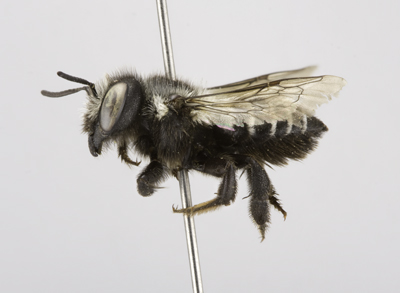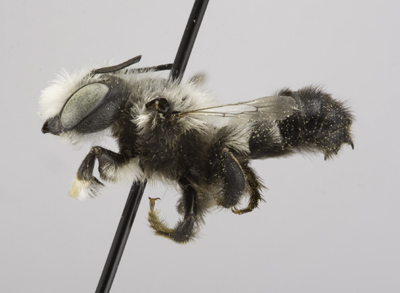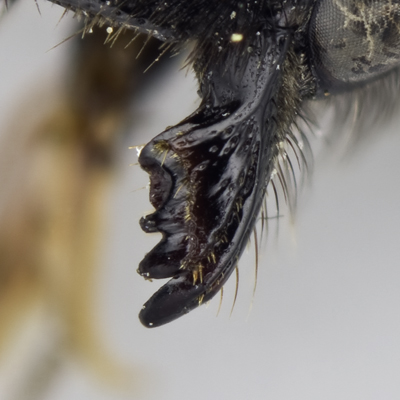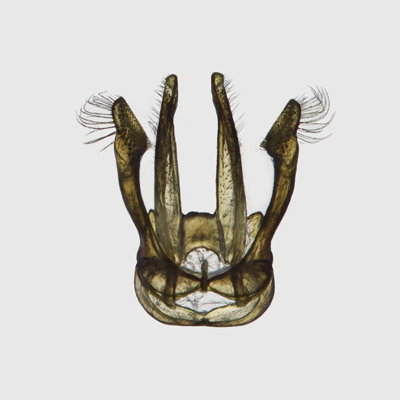
23. Megachile (Megachiloides) subnigra Cresson, 1879
Megachile subnigra Female |
Megachile subnigra Male |
Megachile subnigra Cresson, 1879. Trans. Amer. Entomol. Soc. 7: 208 (♀, ♂).
Megachile (Xeromegachile) angelica Mitchell, 1934. Trans. Amer. Entomol. Soc. 59: 318 (♂).
Megachile (Xeromegachile) blaisdelli Mitchell, 1934. Trans. Amer. Entomol. Soc. 59: 336 (♀).
Megachile (Xeromegachile) moschata Mitchell, 1934. Trans. Amer. Entomol. Soc. 59: 338 (♀).
Diagnosis.The female of M. subnigra is distinct; this is the only species in Canada with entirely black scopa. The male of M. subnigra is distinct, and is recognized by the combination of conspicuously pale coloured and greatly modified front legs, a rounded postmedian tranverse carina on T6, mesepisternum without protuberance; T5 with a white apical fascia, hind tarsomeres that are broad apically, and legs mostly black pubescent.
FEMALE: Length 11-12 mm.
Head:
Figure M23: Megachile subnigra female mandible |
1) compound eyes subparallel; lateral ocelli subequally distant from eyes and edge of vertex, 2) clypeal margin straight, slightly thickened and shining, 3) mandible 4-dentate, with an incomplete cutting edge between the 2nd and 3rd teeth, complete between the 3rd and inner teeth, emargination between the inner and 3rd teeth distinctly oblique with the greatest depth in the emargination much closer to the inner tooth than to the 3rd tooth (Figure M23), 4) gena slightly broader than compound eye (7:6), 5) punctures close and fine, slightly separated on vertex laterally, finely rugosopunctate on face below median ocellus with an obscure, narrow, shiny impunctate line on frons and supraclypeal area, somewhat more coarse and distinct on lower portion of clypeus, 6) pubescence of face black and erect, scarcely obscuring surface beneath, paraocular often with patches of elongate, white pubescence, 7) F1 longer than broad (2:1.5), and longer than pedicel and F2, which are quadrate, remaining flagellomeres slightly longer than broad, apical flagellomere elongate (3:2).
Mesosoma:
1) pubescence short, white on mesoscutum, scutellum, upper parts of pleura, with long, dense white tufts on pronotal lobe and behind wing base, pubescence otherwise black, scarcely obscuring surface, entirely dark on legs, 2) punctures close and fine on dorsal surface, slightly more separated on pleura, more shallow and sparse (> 1 pd) on propodeum, triangle smooth and impunctate, 3) hind basitarsus expanded medially, slightly narrower and shorter than its tibia, 4) tegula reddish-brown, shiny with sparse, minute punctures, 5) wings subhyaline, slightly darker apically, the veins brownish-black.
Metasoma:
1) terga at most slightly depressed basally, T2-T4 with a subcarinate basal rim, slightly depressed apically on T2-T4, T2 with pale apical fascia, fasciae of T3 and T4 with a few white hairs on lateral margins, T6 straight in profile with visible erect pubescence; punctures minute and close on metasoma basally, becoming quite sparse on the shining apical terga, but rather close on T6; pubescence white on T1 and T2, otherwise black, a few black hairs at extreme sides of T2 which is otherwise white pubescent, 2) scopa entirely black, punctures fine and close on basal sterna, becoming coarser and more sparse on apical sterna, sterna with narrow hyaline rims.
MALE: Length 10-11 mm.
Head:
1) compound eyes subparallel; lateral ocelli slightly nearer eyes than edge of vertex (5:6), 2) clypeal margin entire, though slightly produced medially, this area shiny and impunctate, 3) mandible 3-dentate, the 2nd tooth much closer to the apical tooth than the inner one, lower process acute, subbasal in position, 4) gena slightly broader than compound eye (5:4), 5) punctures fine, shallow, but rather close on gena, becoming deeper and more distinctly separated on vertex and between lateral ocelli and eyes, fine and close on face below median ocellus, slightly separated in basal half of clypeus, 6) pubescence entirely white on head, dense and elongate on face below median ocellus, on clypeus and supraclypeal area, gena below, and medially on vertex, 7) F1 about as broad as long, slightly longer than pedicel and subequal in length to F2, the remaining flagellomeres slightly longer than broad (5:4), apical flagellomere flattened and broadly dilated.
Mesosoma:
1) pubescence white on dorsal surface and propodeum, with dense long white tufts on pronotal lobe and behind wing base, becoming dark on pleura below level of wing, pale on front coxa and most of front femur; entirely black on mid and hind legs, the mid tarsal fringe brown, long and conspicuous; front tarsal fringe white above, blackish toward base and beneath, 2) punctures fine and slightly separated throughout, but more distinctly separated near centre of mesoscutum and on scutellum medially, well separated on pleura above, becoming more crowded below, propodeum with fine punctures separated by about 1 pd, triangle smooth and impunctate, 3) front coxal spine flattened, broadly triangular with acute point, broad at base, with a patch of reddish bristles on outer half of base, coxal surface otherwise bare; front femur mostly dark, the polished anterior face becoming dark red, with lower margin distinctly keeled apically, front tibia dark on outer face except for the yellowish apex, largely yellowish-red apically on the other two faces; front tarsus yellowish and dilated, but distinctly narrower than its tibia, the anterior margin deeply excavated, tarsomeres 2 and 3 with a dark spot ventrally, hind basitarsus very short, about half as long as its tibia, 4) tegula black, shiny, finely and sparsely punctate, 5) wings subhyaline, slightly clouded apically, the veins dark brown.
Metasoma:
1) terga only slightly depressed basally but without carina, rather deeply depressed apically, carina of T6 slightly irregularly crenulate, produced medially into a triangularly pointed projection, the apical margin with carinate median teeth that are slightly nearer the lateral teeth than to each other; T7 conspicuous, produced medially into an acute spine; punctures minute and close on metasoma basally, but becoming quite sparse on the shining, more apical terga, T6 more finely and closely punctate; pubescence white on T1 and T2, though some specimens with black hairs laterally on the disc of T2, with lateral apical fasciae of white hairs, pubescence entirely black on T3-T6, though T3 of some specimens with reduced lateral apical fascia of white hairs, 2) S1-S4 visible, apical margins depressed and hyaline, closely punctate basally, becoming sparser on S3-S4, apical fasciae of long dark hairs on lateral margins becoming shorter medially, discs thinly pubescent with shorter black hairs.
Genitalia: Figure G23.
|
Figure G23: Megachile subnigra genitalia |
Discussion:
As with M. anograe and M. sublaurita, this species occurs in both pale and melanistic forms; only the melanistic form has been found in Canada. This species probably nests in the ground (Table 1).
Distribution:
Southern BC (see Map 23).
|
Map 23: Canadian distribution of Megachile subnigra |




